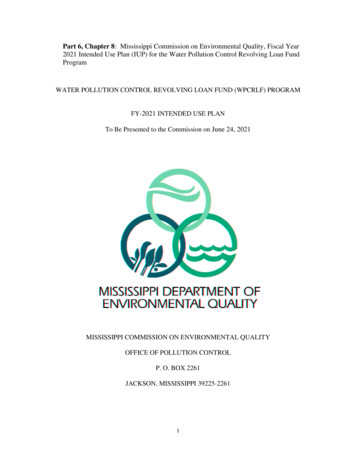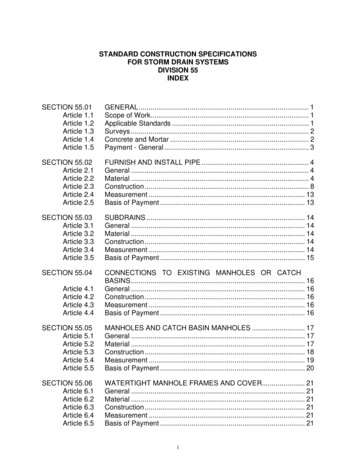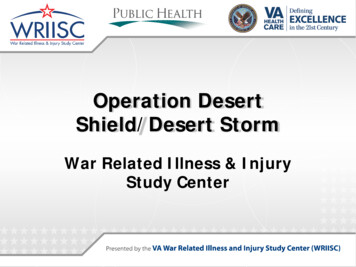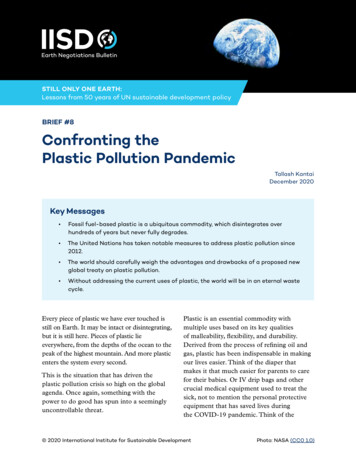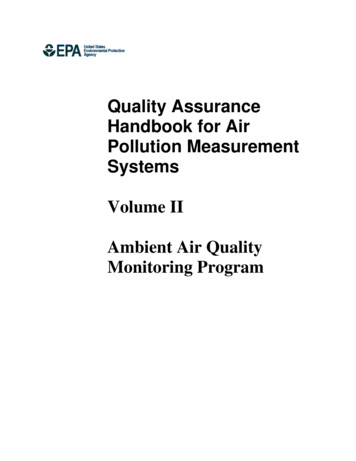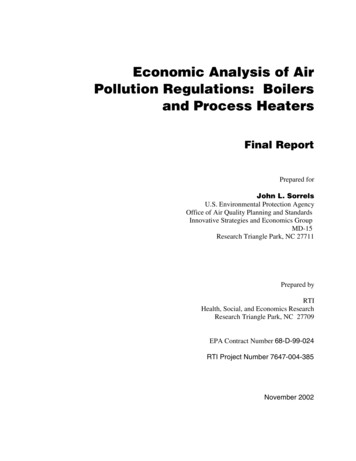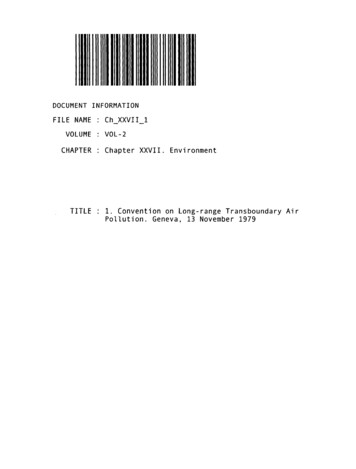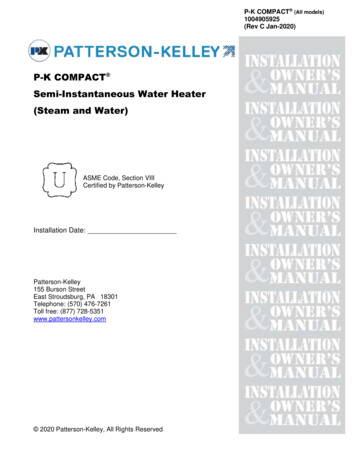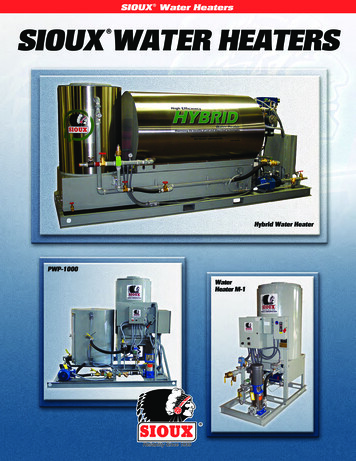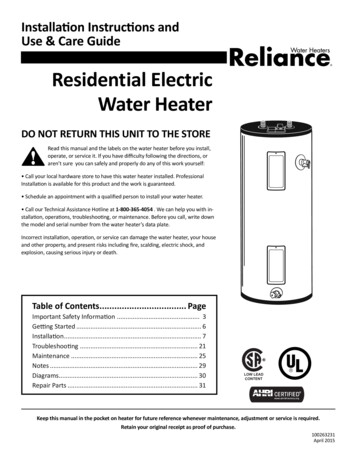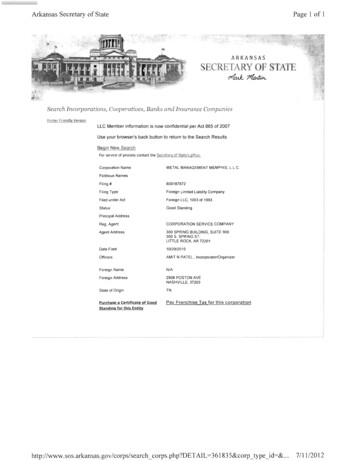
Transcription
((3.7 ACRES)(4.5 ACRES)(800) 588-7962www.ensafe.comcreative thinking.custom solutions.
SIMS METAL MANAGEMENTCLEAN WATER ACT COMPLIANCE PLANSLONOKE YARD301 FRONTAGE ROADLONOKE, ARKANSAS 72086STORM WATER POLLUTION PREVENTION PLAN, MAY 2012Appendix A Facility DiagramsAppendix B Facility Oil Storage and Potential Pollutant Sources InventoryAppendix C Example FormsAppendix D Storm Water PermitAppendix E Best Management Practices ManualAppendix F Training PresentationsAppendix G RecordsPrepared for:Sims Metal Management304 West BankheadNew Albany, Mississippi 38652(662) 538-7100www.simsmm.comPrepared by:EnSafe Inc.5724 Summer Trees DriveMemphis, Tennessee 38134(901) 372-7962(901) 588-7962www.ensafe.com
Table of ContentsSWPPP CERTIFICATION .iNON-STORM-WATER CERTIFICATION . ii1.0INTRODUCTION .1-11.1Regulatory Drivers . 1-21.2Storm Water Pollution Prevention Plan Requirements . 1-31.3Pollution Prevention Team . 1-31.3.1 General Manager . 1-41.3.2 Storm Water Team Members . 1-52.0FACILITY INFORMATION. 2-12.1Facility Location . 2-12.2Activities at Facility . 2-12.3Site Map .2-22.4Description of Drainage Basins . 2-32.5Section 313 Reporting Requirements . 2-32.6History of Spills and Leaks . 2-42.7Scrap Metal Recycler SWPPP Requirements . 2-42.7.1 Inbound Recyclable and Waste Material Control Program . 2-42.7.2 Outdoor Scrap and Waste Material Stockpiles/Storage . 2-52.7.3 Covered or Indoor Scrap and Waste Material Stockpiles/Storage . 2-52.7.4 Scrap and Recyclable Waste Processing Areas . 2-63.0INVENTORY OF POTENTIAL POLLUTANT SOURCES AND CORRESPONDING BESTMANAGEMENT PRACTICES . 3-13.1Best Management Practices . 3-13.2Scrap Metal Recycler BMPs . 3-43.2.1 Inbound Recyclable and Waste Material Control Program . 3-43.2.2 Outdoor Scrap and Waste Material Stockpiles/Storage . 3-53.2.3 Covered or Indoor Scrap and Waste Material Stockpiles/Storage . 3-63.2.4 Scrap and Recyclable Waste Processing Areas . 3-63.2.5 Spill Prevention and Response Procedures . 3-73.3Non-Storm-Water Discharge Management . 3-83.4Preventive Maintenance Program . 3-94.0ANALYSIS OF HISTORICAL AND POTENTIAL POLLUTANTS . 4-14.1Sampling Data .4-14.2Pollutants .4-14.3Discharges to Water Quality Impaired/Water Quality Limited Waters . 4-25.0STORM WATER INSPECTION AND EVALUATION PROGRAM . 5-15.1Quarterly Facility Inspections . 5-15.2Visual Outfall Examination . 5-25.3Non-Storm-Water Discharge Assessments and Certification. 5-35.4Storm Water Monitoring . 5-35.5Annual Comprehensive Site Inspection and SWPPP Evaluation . 5-55.6Record Keeping and Updating Requirements . 5-66.0EMPLOYEE TRAINING .6-1
7.0SPILL PREVENTION AND RESPONSE . 7-18.0MANAGEMENT OF RUNOFF . 8-19.0PERMIT AND SWPPP ADMINISTRATION . 9-19.1SWPPP Availability . 9-19.2Required SWPPP Modifications . 9-19.3Signature Requirements . 9-19.4Record Keeping . ermitted Storm Water Discharges . 1-3Storm Water Team . 1-4Industrial Drainage Basin Summary . 2-3Risk Identification and Summary of Potential Pollutant Sources . 4-1TMSP Analytical Monitoring Requirements . dixAppendixAppendixABCDEFGFacility DiagramsFacility Oil Storage and Potential Pollutant Sources InventoryExample FormsStorm Water PermitBest Management Practices ManualTraining PresentationsRecords
SWPPP CERTIFICATIONThis Storm Water Pollution Prevention Plan (SWPPP) was prepared for Sims Metal Management inaccordance with best management practices and in accordance with the factors outlined inTitle 40 Code of Federal Regulations 122.26 as appropriate. It has the full approval of managementat a level of authority to commit the necessary resources to ensure full SWPPP implementation. ThisSWPPP will be implemented as described herein, and will be reviewed and evaluated annually.I certify under penalty of law that this document and all attachments were prepared under my directionor supervision in accordance with a system designed to assure that qualified personnel properly gatherand evaluate the information submitted. Based upon my inquiry of the person or persons who managethe site, or those persons directly responsible for gathering the information, the information submittedis, to the best of my knowledge and belief, true, accurate, and complete. I am aware that there aresignificant penalties for submitting false information, including the possibility of fine and imprisonmentfor knowing violations.SignatureDateGary HensleyNameGeneral ManagerTitlei
NON-STORM-WATER CERTIFICATIONEPA MSGP 2008 5.1.3.4: Non-Storm-Water Discharges. You must document that you have evaluated for the presenceof non-storm-water discharges and that all unauthorized discharges have been eliminated. Documentation of yourevaluation must include: the date of any evaluation; a description of the evaluation criteria used; a list of the outfalls oronsite drainage points that were directly observed during the evaluation; the different types of non-storm-waterdischarge(s) and source locations; and the action(s) taken, such as a list of control measures used to eliminateunauthorized discharge(s), if any were identified. For example, a floor drain was sealed, a sink drain was re-routed tosanitary, or an NPDES permit application was submitted for an unauthorized cooling water discharge.I certify under penalty of law that the facility has been evaluated for the presence of edthroughrepeatedobservationsofthefacility’s outdoor storage and work areas during periods of dry weather. I certify that, to the best ofmy ilityasofthedate.A Non-Storm-Water Evaluation and Certification Form (Appendix C) must be included in theStorm Water Pollution Prevention Plan and must be performed when non-storm-water is observedduring quarterly facility inspections.Signature of Responsible Facility OfficialDateGary HensleyName of Responsible Facility Officialii
Record of SWPPP Review AmendmentsSims Metal bleParty Initials
Storm Water Pollution Prevention PlanSims Metal ManagementLonoke, ArkansasMay 20121.0INTRODUCTIONSims Metal Management’s Storm Water Pollution Prevention Plan (SWPPP) has been prepared with thegoal of improving water quality by reducing pollutants contained in storm water discharges. Meetingthis goal can be a difficult challenge for many reasons. For example, the original sources of pollutantstransported in storm water can be diffused or spread out over a wide area. Small oil and grease spillsat hundreds of different activities within a single facility can collectively represent a major pollutionproblem. In addition, the nature of storm water is such that the amount of pollutants that enter thereceiving waters will vary in accordance with the frequency, intensity, and duration of rainfall and thenature of the drainage patterns.The pollution prevention approach in this SWPPP focuses on three major objectives: Identifying sources of pollution associated with industrial activities that are potentially affectingthe quality of storm water discharges from the facility. Describing and ensuring implementation of practices to minimize and control pollutantsassociated with industrial activities that are entering storm water discharges from the facility. Ensuring compliance with the terms and conditions of the facility’s National Pollutant DischargeElimination System (NPDES) permit.This SWPPP addresses areas at the facility where storm water discharges exposed to source materialscan be practicably prevented or eliminated and identifies potential sources of pollution that may bereasonably expected to affect the quality of storm water discharges.This SWPPP describes the implementation of best management practices (BMPs) at the facility toeliminate or reduce the amount of pollutants in storm water runoff from industrial activity areas to themaximum extent practicable (MEP). BMPs include both structural and nonstructural (operational)practices.Structural practices include secondary containment basins, storm water diversionarycurbing, drain plugs, and similar items constructed or installed to eliminate or reduce the amounts ofpollutants in storm water runoff. Nonstuctural (operational) practices are also referred to as sourcecontrols and include standard operating procedures, schedules of activities, prohibitions on practices,and other management actions that are intended to eliminate or reduce the amount of pollutants instorm water runoff.1-1
Storm Water Pollution Prevention PlanSims Metal ManagementLonoke, ArkansasMay 20121.1Regulatory Drivers40 CFR122.26(b)14): Storm w ater discharge associated w ith industrial activity. Means the discharge fromany conveyance that is used for collecting and conveying storm water and that is directly related to manufacturing,processing, or raw materials storage areas at an industrial plant. The term does not include discharges from facilities oractivities excluded from the NPDES program under this part. For the categories of industries identified in this section, theterm includes, but is not limited to, storm water discharges from industrial plant yards; immediate access roads and rail linesused or traveled by carriers of raw materials, manufactured products, waste material, or by-products used or created by thefacility; material handling sites; refuse sites; sites used for the application or disposal of process waste waters (as definedat part 401 of this chapter); sites used for the storage and maintenance of material handling equipment; sites used forresidual treatment, storage, or disposal; shipping and receiving areas; manufacturing buildings; storage areas(including tank farms) for raw materials, and intermediate and final products; and areas where industrial activity has takenplace in the past and significant materials remain and are exposed to storm water. For the purposes of this paragraph,material handling activities include storage, loading and unloading, transportation, or conveyance of any raw material,intermediate product, final product, by-product, or waste product. The term excludes areas located on plant lands separatefrom the plant's industrial activities, such as office buildings and accompanying parking lots, as long as the drainage fromthe excluded areas is not mixed with storm water drained from the above described areas. Industrial facilities(including industrial facilities that are federally-, state-, or municipally-owned or operated that meet the description of thefacilities listed in paragraphs (b)(14)(i) through (xi) of this section) include those facilities designated under the provisionsof paragraph (a)(1)(v) of this section. The following categories of facilities are considered to be engaging in “industrialactivity” for purposes of paragraph (b)(14):Category (vi) Facilities involved in the recycling of materials, including metal scrap yards, battery reclaimers, salvage yards,and automobile junkyards, including but limited to those classified as SIC 5015 (used motor vehicle parts) and 5093(scrap and waste materials).Sims Metal Management discharges storm water that is associated with industrial activity as defined inthe U.S. Environmental Protection Agency (USEPA) NPDES program established pursuant to theFederal Water Pollution Control Act, as amended by the Clean Water Act (33 U.S.C. 1251 et seq.), andcodified in Title 40 of the Code of Federal Regulations (CFR), Part 122 (40 CFR 122). Specifically, thefacility is a ferrous and non-ferrous metal recycler as defined by Standard Industrial Classification (SIC)Code 5093, and the definition of industrial activity areas in 40 CFR 122.26(b)(14)(vi) includesSIC Codes in the 50 series.Arkansas is a delegated state with NPDES permitting authority.The state’s NPDES program isadministered by the Arkansas Department of Environmental Quality (ADEQ). Arkansas storm waterregulations for storm water discharges associated with industrial activity are codified in the Act 472 of1949 and set forth in the Arkansas Water and Air Pollution Control Act, 8-4-101 et seq., as amended,and the Clean Water Act (33 U.S.C. 1251 et seq.).Sims Metal Management is covered underArkansas’s Storm Water Industrial General Permit for Industrial Activities (ARR00). The general permitis included as Appendix D. Table 1-1 summarizes permit requirements.1-2
Storm Water Pollution Prevention PlanSims Metal ManagementLonoke, ArkansasMay 2012DischargesCoveredPermit No.Table 1-1Permitted Storm Water DischargesPermitEffectiveExpirationPermit DateDatePermit Required ActivitiesReportingRequiredStorm W ater Associated w ith I ndustrial ActivityFerrous andnon-ferrousmetal recycler(SIC Code 5093)ARR0007/01/200906/30/2014Semi-annual analyticalmonitoring from outfall 1 for Al,Cu, Fe, Pb, and Zn; quarterlyfacility inspections includingvisual outfall examinations (atleast 1 during a rain event);annual comprehensive sitecompliance evaluations; periodicdates for employee trainingmaintained with the SWPPPIndustrial StormWater GeneralPermit AnnualReport Formdue to ADEQ byJanuary 31 ofeach calendar yearThe ADEQ can be reached at:Thomas Rheaume, Branch ManagerPermits Branch5301 Northshore DriveNorth Little Rock, Arkansas .2Storm Water Pollution Prevention Plan RequirementsARR00, ACT- 472 in Appendix D specifically requires the facility to develop and implement a SWPPP.In general, this SWPPP follows the regulatory requirements for SWPPPs outlined in 40 CFR 122.26,USEPA Multi-Sector General Permit (MSGP) for storm water discharges associated withindustrial activity (EPA MSGP 2008), and ARR00. The SWPPP discusses the facility’s conformance tothe applicable regulatory requirements of that section. In general, the federal regulations are cited atthe beginning of each appropriate section. If the state regulations are more stringent, they arediscussed in the applicable section.1.3Pollution Prevention TeamEPA MSGP 2008 5.1.1: Storm W ater Pollution Prevention Team . You must identify the staff members (by nameor title) that comprise the facility’s storm water pollution prevention team as well as their individual responsibilities. Yourstorm water pollution prevention team is responsible for assisting the facility manager in developing and revising thefacility’s SWPPP as well as maintaining control measures and taking corrective actions where required. Each member of thestorm water pollution prevention team must have ready access to either an electronic or paper copy of applicable portionsof the permit and SWPPP.The SWPPP Team identifies potential pollutants and spill sources and develops environmental incidentreporting procedures. The team develops and coordinates spill prevention and response procedures1-3
Storm Water Pollution Prevention PlanSims Metal ManagementLonoke, ArkansasMay 2012and provides prompt notices to appropriate agencies and environmental contractors.The teamdevelops storm water pollution prevention, inspection, and record-keeping procedures; reviewsenvironmental occurrences to evaluate the need for modifications to the SWPPP; andimplements subsequent amendments to the SWPPP.The responsibility for storm water pollution prevention for the site lies with Sims Metal Management’sfacility’s General Manager. The General Manager directs the efforts of the storm water team to ensurethe actions required by the SWPPP are implemented.Table 1-2 lists the lead members of thestorm water team and their responsibilities are presented in subsequent sections.Table 1-2Storm Water TeamNameGary Hensley—Kelly Walton—Amanda Crafton —Work PhoneGeneral ManagerLonoke Facility ManagerSouthern Region SHEC Manager(901) 521-4400(205) 420-9267(901) 521-44121.3.1 General ManagerThe General Manager has the responsibility and authority to accomplish the following: Coordinating the storm water team and develop BMPs, inspection procedures, staff training,and facility maintenance programs to ensure compliance with the SWPPP. Conducting inspections and maintain inspection logs to determine the need for changes to theSWPPP. Ensuring that required monitoring is performed and results documented. Reviewing monitoring results and initiate corrective action following adverse monitoring reportsto ensure compliance with the SWPPP and appropriate regulatory r
Jun 19, 2012 · Appendix B Facility Oil Storage and Potential Pollutant Sources Inventory Appendix C Example Forms Appendix D Storm Water Permit Appendix E Best Management Practices Manual Appendix F Training Presentations Appendix G Records . Prepared for: Sims Metal Management 304 West Bankhead Ne
